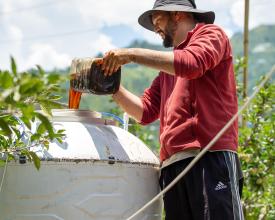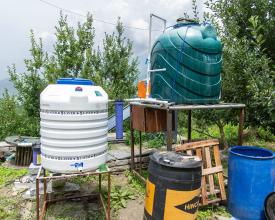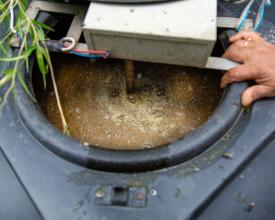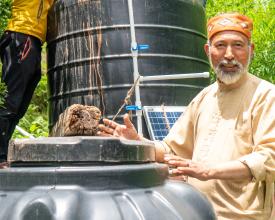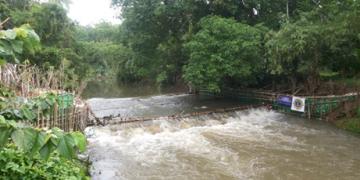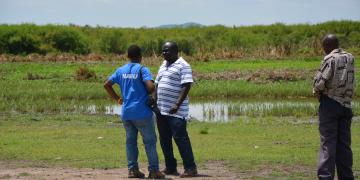
Use of Solar Bio-Fermenters for Nutrition and Soil Health Management
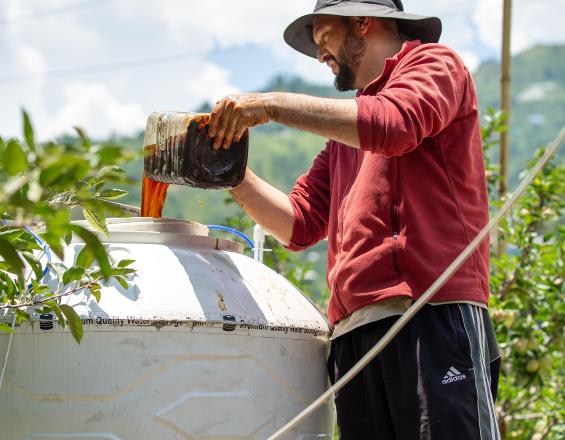
Declining soil health and biodiversity loss, rising input costs, and decreasing fertilizer effectiveness all point to a common potential solution: a transition to more sustainable systems of agriculture, with reduced dependence on chemical-based inputs.
A key enabler in this transition can be the utilisation of biofermenters for producing high quality biological inputs on farm. It helps to restore soil ecosystems, increase farmers’ resilience to climate change, and to reduce dependence on market-sourced inputs. Implementing complementary practices such as intercropping and mulching further enhances these benefits.
However, the manual preparation of biological inputs is labour-intensive, time-consuming, and often unpleasant due to strong odours. To overcome these adoption barriers, the Green Innovation Centres - India piloted a solar-powered bio-fermenter for apple farmers in Himachal Pradesh. The solution reduces labour cost, improves input quality, and supports a broader, farmer-led transition to natural farming.
Contexto
Défis à relever
Environmental challenges:
Monocropping and prolonged, excessive use of agrochemicals in Himachal Pradesh’s apple orchards severely degraded soil health by depleting organic matter, disrupting microbial communities, and reducing the soil’s ability to retain water. In addition to soil degradation, runoff from fertilizers and pesticides pollutes water sources and threatens local biodiversity.
Economic challenges:
Fertilizers are a major cost factor for apple growers. While the manual preparation of organic inputs has been recognized by many farmers as a sustainable alternative, it requires up to 60 minutes daily, adding either to labour costs or reducing the time available for other essential farm tasks. These burdens have limited broader adoption.
Social challenges:
Transitioning to sustainable agricultural practices requires shifts in established practices. Without widespread demonstration of viable alternatives, combined with targeted capacity building and support systems, the adoption of natural farming methods remains limited.
Ubicación
Procesar
Summary of the process
The building blocks address technical, financial, and knowledge barriers to adopting sustainable agriculture practices. By making biological input preparation less labour-intensive and improving product quality, the solar-powered biofermenter addresses practical challenges to manual input production. Financing through Farmer Producer Organisations lowers the entry barrier for smallholders and practical training builds farmers’ skills in using and maintaining the system. Together, these elements create a pathway for more farmers to adopt natural farming practices sustainably.
Building Blocks
Solar-Powered Biofermenter
The solar powered bio-fermenter automatizes the fermentation process for preparation of biological inputs. The system comprises two tanks (for fermentation and filtration), a battery-powered motor, and a time controller. The fermenter operates entirely on solar energy and features an automatic slurry stirrer that stirs the mixture six times a day, supplying oxygen at regular intervals to support microbial activity and consistent fermentation. The six-stage filtration process allows the output to be used in different application methods: as slurry for soil application, as a filtered solution for foliar spraying, or through drip irrigation systems.
The bio-fermenter can be adopted at the individual farm level or as part of a shared model. In the community-based approach, one farmer becomes a service provider, preparing natural inputs and supplying them to nearby farmers for a fee. This model supports local entrepreneurship and facilitates broader access to high-quality biological inputs, even for farmers who may not have the time or capacity to operate the fermenter themselves.
Financing
Despite the long-term cost-saving potential of the solar-powered bio-fermenters, uptake of the technology is significantly constrained by the initial investment cost, which are often prohibitive especially for smallholder farmers.
To enable wider access, GIC established a revolving financing model through its partnering Farmer Producer Organisations (FPO) KPM and CVA, which now serve as enablers for uptake by smallholder farmers in the region.
The FPOs have secured a 10-year loan to fund the solar-powered bio-fermenters for their member farmers. Rather than distributing equipment for freevia full subsidies or requiring full upfront payments, the FPOs implemented an internal repayment system, allowing farmers to repay the cost gradually over a one-year period.
Each year, a new group of farmers is supported using the repayments collected from the previous cycle. This system allows the same funds to circulate annually, effectively reaching a greater number of beneficiaries without the need for repeated external financing.
The model reduces financial pressure on individual farmers, encourages responsible repayment, and strengthens the FPOs’ role as financial facilitators for their members. It also ensures that access to equipment is not limited to those who can afford high upfront costs or navigate formal credit systems, making the model far more inclusive and scalable.
Training Module on Biofermenters
Alongside the technical solution and the financial model, GIC developed a training module, which assures that farmers who adopt the solution are prepared to produce and apply biological inputs such as Jeevamrut (liquid organic fertilizer), Ghanjeevamrut (solid organic fertilizer), and Neemastra (natural pest control).
Based on this module, all adopting farmers were trained on how to safely operate the system, how to maintain it, ensuring consistent fermentation quality and system longevity, and how to carry out basic troubleshooting to avoid the need for external technical support. Furthermore, they received training on the formulation of different organic inputs and their use in soil, foliar, and drip irrigation systems. Basic principles of nutrient management were also introduced, emphasizing balanced fertilisation and the role of these inputs in maintaining soil health.
By building these skills and understanding through the practical training sessions, the module supports farmers in adopting natural farming methods with greater confidence. Furthermore, it serves as a replicable model for scaling the use of biofermenters and natural inputs across other regions and contexts.
Impacts
Environmental Impacts
The solar-powered bio fermenter avoids greenhouse gas emissions associated with fuel-based mechanisation. It enables the use of natural inputs without reliance on chemical fertilisers or pesticides, supporting better soil structure, microbial life, organic carbon levels, and water retention. These changes help restore degraded soils affected by monocropping and chemical overuse in Himachal Pradesh’s apple orchards.
Social Impacts
The fermenter reduces physical strain and improves working conditions by replacing manual stirring with automated solar-powered mixing. It enables more consistent and timely preparation of biological inputs, supporting greater continuity in natural farming practices. When used collectively, it fosters resource-sharing within farming communities and local business models.
Economic Impacts
The solution reduces the need for hired labour and costly chemical inputs. Uniform stirring improves the quality of the fermented product which contributes to better plant health and yield. Producing inputs on-farm strengthens farmer self-reliance and lowers production costs, while community use models offer the potential for service-based income.
Beneficiaries
Apple farmers and surrounding communities directly benefited. The solution can also support farmers in other regions and value chains adopting natural farming and local input preparation.
Global Biodiversity Framework (GBF)
Sustainable Development Goals
Story
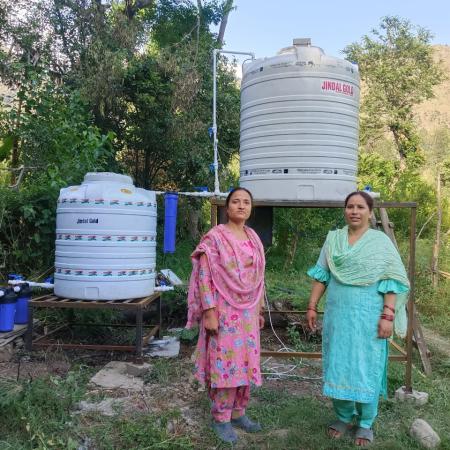
Rama Devi, a woman farmer from kullu, Himachal Pradesh, India, here narrates how she and her group members benefitted from a solar-powered biofermenter:
We are farmers from Himachal Pradesh, and also work as community organisers for some government programmes, where we make women in our villages aware on better agriculture practices and mobilise them for training programmes. In the beginning we were trained on agriculture and learnt how to prepare different biological inputs like jeevamrit and ghanajeevamrit, which are prepared from cow dung and other farm residue and enhance soil health. Then we continued with mobilising women together in our groups and facilitated their participations in trainings organised as part of government initiatives. Our goal was that they also become self-reliant. Earlier, the women in our villages would not even step out of their house, but after these trainings, we started small scale nutrition gardens in our homes, where we did not use any chemicals and only practised sustainable techniques using bio-inputs.
Our groups were trained by the GIC project on food processing, where we learnt how to prepare different products from apple and other crops. We display them in local exhibitions, fairs, and events, where they are sold and generate extra income for us. Since our family incomes are sometimes not enough to meet all household needs, we want to work so we can support our families and also be equal to them.
The GIC supported us to install a bio-fermenter in our farms, which made our work much easier. It has reduced our work and effort to follow sustainable practices, our input costs, and allowed for the possibility of using produce from the nutrition gardens in our houses as well as selling it in the market.
Our group of 20 women farmers even established a community nutrition garden. We collect raw materials like cow dung from each house to prepare the inputs together. Now we are collecting our produce and sell it collectively in the local market, since selling them individually was not possible as the quantity each of us produced alone was too small. We are very happy with the bio-fermenter and hope that our groups will continue to use it.
